Oil & Gas
Characterization and modeling of naturally fractured (NFR) reservoirs
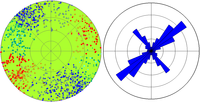 Stereonet and rose-diagram of fracture orientations.
Stereonet and rose-diagram of fracture orientations.
- Development of a geostatistical approach for the data integration problem of modeling naturally fractured reservoirs from various fracturing, structural, seismic, geomechanical, geological, logs and dynamic data. Application to several (6) fields.
- Research, design and development of libraries and APIs dedicated to NFR data analysis and modeling.
- Interactive and automatic statistical classification of fractures.
- Parameter estimation of probability distribution functions of fracture orientation.
- Calculation of along-well fracture densities (FD) on a directional fracture-set basis.
- Statistical analysis of along well scale-dependent fracture densities (SiZer-like approach).
- Geostatistical simulation of FD.
- Analytical method for calculating interlayer fracture permeabilities accounting for persistent and bedding-terminated fractures.
- Generation of spatially periodic fracture systems for calculating observation scale-dependent equivalent/effective within-layer permeability tensors and other flow properties (block sizes, shape factor).
- Flow-based evaluation of interpreted well-test permeabilities on reservoir models (permeability-tensor fields).
- Sensitivity analysis to relate static model parameters to equivalent/effective flow properties.
- Automatic calibration (inversion) of NFR model to condition equivalent/effective permeability-tensor fields to dynamic data.
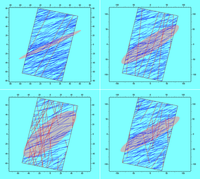 Effective permeability tensors relying on spatially periodic fracture systems.
Effective permeability tensors relying on spatially periodic fracture systems.
suite...
- Characterization and modeling of fracture swarms and corridors: research, design and development of statistical analysis tools for characterizing scale-dependent fracture densities (FD) and statistically recognizing fracture swarms. Geostatistical simulation of probability density functions of fine-scale FD.
- Design and development of a plugin and workflow in Gocad for modeling naturally fractured reservoir (GoFraK). Implementation of all previous libraries to make them easily available in a geological modeling software.
- Technical support on geostatistical modeling of fracture densities for commercial software developments.
(suite)
Petroleum geostatistics
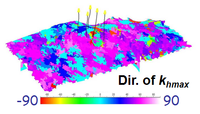
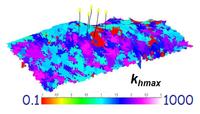 Maximum horizontal permeability direction and value derived from geostatistically simulated fracture densities.
Maximum horizontal permeability direction and value derived from geostatistically simulated fracture densities. 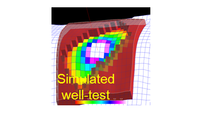 Conditioning of permeability tensor fields to well-test data.
Conditioning of permeability tensor fields to well-test data.
- Design and development of geostatistical modules (estimation, simulation) within an integrated geostatistical software for reservoir characterization and modeling.
- Petroleum reservoir modeling for flow simulation studies.
- Assessment of infill drilling potential and connected pore volumes for enhancing production in petroleum reservoirs.
- Exploitation of 3D-seismic data to optimize the number and location of exploration wells in a bitumen field.
- Integration of 3D seismic attributes to assist with selection of horizontal drilling locations for development drilling.
- Elaboration and realization of an interactive methodological guide for probabilistic assessment of in place hydrocarbon resources.
- Calculation of metric curvilinear coordinate systems for better capturing the spatial continuity of reservoir properties.
(suite)
Grid generation and upscaling
 Grid/mesh generation and optimization.
Grid/mesh generation and optimization.
- Research work on adaptive gridding algorithms for different types of reservoir simulators and gridding optimization objectives.
- Development of 3DDEGA, a three-dimensional adaptive gridding software able to recognize and capture reservoir heterogeneities and flow paths, and to compute effective properties of heterogeneous adapted grid-blocks. Assistance for its use.
- Design and development of several mesh generation and optimization programs for reservoir simulation.
- Automatic generation of anisotropic tetrahedral meshes embedded in hexahedral grids (constrained Delaunay and Voronoi meshes) for modeling complex wells.
- Generation and optimization of 2D anisotropic triangular meshes for simulating multiphase flows in highly fractured media.
- Three-dimensional flexible mesh optimization taking into account well layouts and reservoir discontinuities.
suite...
- Technical support on automatic and adaptive gridding for commercial software developments.
- European Thermie project for the demonstration of adaptive gridding on actual reservoir data sets. Two-year project in collaboration with the Paris School of Mines (F) and SMC Ltd (UK). Data-sets provided by Agip, Elf Aquitaine, Norsk Hydro and Total. Three reservoir simulators used: Eclipse, VIP, Genesys.
